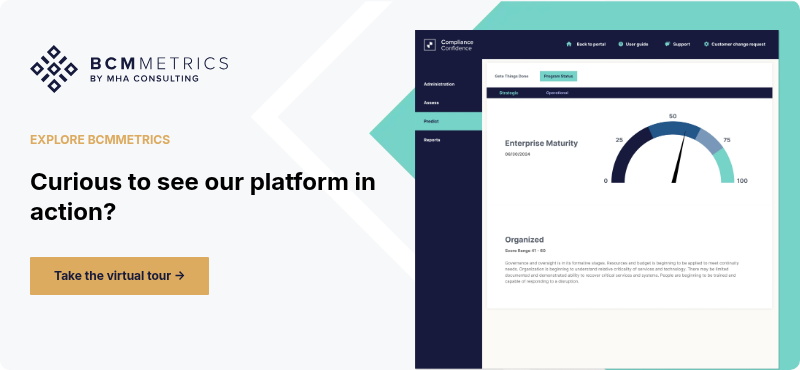Prepare For the Worst with the Best in the Business
Experience capable, consistent, and easy-to-use business continuity management software.
Everyone likes getting a return on their investments, but when it comes to business continuity management (BCM), a too-rigid focus on traditional return on investment (ROI) can be counterproductive. In today’s post, we’ll look at a better way to think about ROI and business continuity.
The Funding Challenge: Why We Look for ROI in the First Place
Understandably, business continuity professionals feel pressure to justify their budgets. Resources are finite, and leadership wants to know that continuity efforts are delivering measurable value. So there’s a natural instinct to present business continuity in familiar financial terms, namely, ROI.
This is especially true when the organization hasn’t had a major disruption. Without a recent event to anchor the conversation, continuity teams are often asked to make the case for something that, in leadership’s eyes, hasn’t yet proven its worth.
That puts continuity teams in a tough spot. They’re asked to calculate the ROI of the BC program, even though such programs don’t readily lend themselves to this metric. It’s like asking for the ROI of the fire ladder you keep in the children’s second-floor bedroom. If nothing happens, it’s zero. If there’s a fire, that ladder becomes priceless.
Really the question isn't whether ROI is a useful concept. The question is whether it's the right tool for evaluating a resilience initiative. It isn’t the only metric or rationale.
The Problem with ROI Math in Business Continuity
Trying to quantify BCM value in hard financial terms rarely produces a credible number. It’s not that the math is flawed in theory. It’s that it relies almost entirely on hypotheticals.
Trying to tally up the avoided support costs or averted penalties quickly becomes an exercise in creative writing. And leadership teams know it. They’ve seen inflated ROI claims before, and they’re quick to spot when the math is more wishful than rigorous.
If continuity teams try to sell business continuity management as a cost-saving center and can’t back it up with real, defendable numbers, it puts the entire program at risk. That’s why the more honest, and ultimately more strategic, path is to reframe the conversation.
A More Useful Lens: Think of BCM as Insurance
Rather than forcing BCM into a financial ROI box, a better analogy is insurance. You don’t buy auto insurance to reduce costs today. You buy it so you’re covered if the worst happens.
No responsible person would drive without car insurance or willingly go without health insurance. No responsible organization should go without an adequate BC program.
Business continuity is the same. It’s a risk management decision, not a cost-cutting strategy.
The insurance analogy illuminates something else critical about spending on BC: the importance of right-sizing your program. Imagine you’re deciding how much insurance to carry on your car. If you drive a brand-new $40,000 SUV, you’ll want full coverage. If you’re driving an old sedan with 200,000 miles on it, you might opt for something less. The point is, you match the investment to the risk.
BCM works the same way. Some systems or operations are mission-critical and justify robust continuity strategies. Others aren’t and don’t. The value of continuity planning comes from tailoring the solution to the threat, not from promising it will save money.
Continuity professionals should focus on answering this question: What level of disruption can we tolerate, and what are we doing to stay within that tolerance? That’s not about ROI. That’s about appropriateness and risk mitigation.
There Are Tangible Benefits If You Look in the Right Places
All that said, a well-run BCM program can produce measurable benefits, they just don’t fall neatly into an ROI formula. These benefits are derived from both the IT disaster recovery (IT/DR) and business continuity aspects of the program and include both direct cost avoidance and operational gains:
Four Direct Benefits
- Minimized operational disruption
- Both IT/DR and BC plans reduce downtime and ensure critical systems and business functions keep running during outages or emergencies.
- Discover how to choose the right business continuity and IT disaster recovery software.
- Financial protection
- Effective planning helps avoid revenue loss, reduce penalties, and limit costs associated with overtime or workaround efforts caused by disruptions.
- Audit and compliance readiness
- Maintaining documented, tested plans helps organizations meet regulatory requirements and address audit expectations efficiently.
- Brand and reputation safeguarding
- Prompt and coordinated recovery efforts protect customer trust and prevent revenue loss tied to reputational damage.
Four Indirect Benefits
- Process and technology insight
- Developing recovery strategies uncovers hidden dependencies, integration points, and inefficiencies across processes and IT systems, enhancing organizational understanding.
- Technology consolidation and cost-efficiency
- Recovery planning often highlights opportunities to retire obsolete or redundant technologies, streamlining operations and reducing ongoing costs.
- Cross-functional collaboration and improved execution
- Engaging multiple teams in planning fosters better communication, aligning IT and business functions, which accelerates project delivery and reduces errors even beyond continuity initiatives.
- Business process improvement
- Detailed business impact analyses reveal previously unknown or undocumented processes, enabling potential process integration, cost reduction, and capacity enhancement.
These aren’t “bonus perks.” They’re real and often significant gains, but they reflect process maturity, not profit margins. Framing them as value-adds (rather than bottom-line returns) keeps the conversation realistic and grounded.
When ROI Thinking Does Help: Use It to Calibrate, Not Justify
To be clear, there is a role for ROI-type analysis in BC, just not the one most people think.
It’s certainly possible and it can be valuable to model the financial impact of various scenarios, such as how much it would cost per hour if a certain system or factory went down or if the organization was unable to ship product.
Such numbers help teams understand what’s at stake and whether the cost of mitigation makes sense. But the value of these numbers isn’t in helping you generate an ROI figure, it’s in helping you right-size your BC solution. In these cases, cost modeling is a strategic input rather than a sales pitch.
BCMMetrics: A Tool To Improve ROI
Right-sizing your program and realizing both the direct and indirect benefits of business continuity, is no small task. It requires thoughtful prioritization, cross-functional coordination, and an honest view of your current capabilities. Many organizations have found that software platforms can be a helpful aid in this work, especially when the initial investment is modest compared to the value they provide.
If you’re exploring options in this space, you might consider BCMMetrics, a platform developed by MHA and used by our consultants every day in client engagements. BCMMetrics is a practical, cloud-based tool suite designed to help organizations assess their risk, manage compliance, and structure their programs in a way that’s sustainable over time.
The platform includes four core tools:
- Compliance Confidence lets you measure your program against standards such as ISO 22301 and NFPA 1600, helping you identify gaps and track improvement.
- BIA On-Demand provides a structured workflow for conducting business impact analyses with consistency and clarity.
- BCM Planner offers a centralized space for drafting, editing, and maintaining recovery plans.
- BCM One, a map-based interface, helps visualize your facilities and access the plans and contacts associated with each location.
No tool can replace sound strategy, but with the right support, you can make smarter decisions faster and keep your continuity program aligned with your organization’s risk tolerance and resilience goals.
Rethink the Metric, Strengthen the Mission
It’s natural to want to justify your continuity program in ROI terms. But BC doesn’t readily fit that mold, and if you try to sell it that way, your executives are likely to be skeptical.
A better approach is to frame BC as being similar to an insurance policy, one tailored to provide appropriate protection to your most important systems, applications, and processes. Whether you choose to leverage external tools and expertise or build your program internally, the goal is the same: a right-sized, resilient program that prepares you to face disruption with clarity and control.
To discover the BCMMetrics system in action, do our virtual tour.
Further Reading
- Defense in Depth: True Resilience Requires Business Continuity and Operational Resilience
- Getting Started with BCaaS: MHA’s Approach to Business Continuity as a Service
- We’ve Got Your Back: How MHA’s Program Augmentation Service Can Boost Your BC Program
- Want to Get Better at Crisis Management? Start with Culture
- The 6 Toughest Challenges in BC (and How Software Can Help Tame Them)

Richard Long
Richard Long is one of MHA’s practice team leaders for Technology and Disaster Recovery related engagements. He has been responsible for the successful execution of MHA business continuity and disaster recovery engagements in industries such as Energy & Utilities, Government Services, Healthcare, Insurance, Risk Management, Travel & Entertainment, Consumer Products, and Education. Prior to joining MHA, Richard held Senior IT Director positions at PetSmart (NASDAQ: PETM) and Avnet, Inc. (NYSE: AVT) and has been a senior leader across all disciplines of IT. He has successfully led international and domestic disaster recovery, technology assessment, crisis management and risk mitigation engagements.
.png)
.png)




